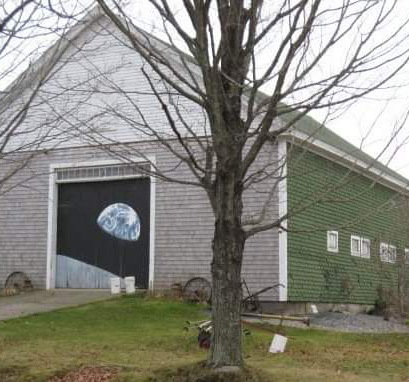
The seed of this story was planted fifty-two years ago. I was seventeen, a student at a remarkable school that saved my life. Teachers and classmates at the Quaker Meeting School became my chosen family. It was a place where everyone contributed. Everyone had a purpose. In the mornings before classes began, we would gather for announcements and sing songs while some of us were still rubbing the sleep from our eyes. I remember the singing as a special time in which we all felt connected.
Thirty-four years later, in 2004, the school was still going. The head of the school asked if I would make film showing how the school’s emphasis on living in a loving spirit, in community, nourished young minds and souls. I was filming the morning singing when I first heard Swimming To the Other Side The words moved me.
We are living neath the great big dipper,
We are washed by the very same rain,
We are swimming in this stream together,
Some in power and some in pain.
We can worship this ground we walk on,
Cherishing the beings that we live beside.
Loving spirits will live forever,
We’re all swimming to the other side.
The song stayed with me. Eleven years later I was in the middle of a divorce, going through a rough time. I signed up for a class that promised to teach you how to perform your favorite song. I chose Swimming To The Other Side.
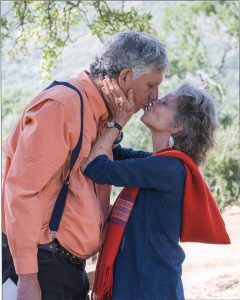 Another year passed. I fell in love with Sharon and I sang the song to her. We got married.
Another year passed. I fell in love with Sharon and I sang the song to her. We got married.
During COVID Sharon wrote her memoir, Burning Woman, and put the words of the song in her book. Just before it went to press, she got an email from the publisher. It appeared that she did not have permission to use the lyrics in her book. Because the song has the feel of an old anthem, I thought Quakers had been singing it for hundreds of years. It turns out it was written by Pat Humphries in 1990.
Days before the printer’s deadline we located Pat. She gave Sharon permission to put the lyrics in Burning Woman, but wanted to know more. In what context will the song being be used? Might we talk on the phone?
The call started out with Sharon answering Pat’s questions but soon we were on speaker phone and I shared with Pat about hearing her song at The Meeting School. Coincidentally, Pat told us she sang the song at a benefit for a sister Quaker school, the John Woolman School. There were other synchronicities. Pat’s mentor was the great folk singer, Pete Seeger. He was also my hero. We’d both sailed on Pete’s great wooden sloop, the Clearwater, a floating environmental classroom which had a huge impact on the cleanup of the Hudson River. Both of our grandmothers had died in the flu epidemic of 1918.
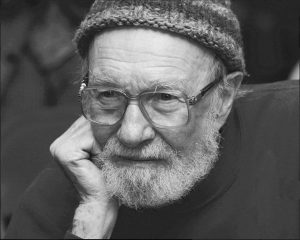
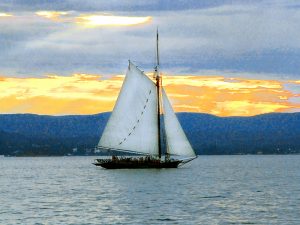
I asked Pat if anyone had made a documentary film about her and her singing partner, Sandy O. Someone had started thirteen years ago, but had to leave the project unfinished. “Let’s talk,” I said. As a filmmaker, I wanted to figure out a way I could support them and their work. It took a while. My emails and calls went unanswered. I figured Pat and Sandy thought I was just some groupie who wanted to follow them around with his camera. On one level this was true, but I saw the two women as part of a long and venerable tradition of singer-songwriter-activists, stretching back to Pete Seeger and Woodie Guthrie. They named their duo Emma’s Revolution, after the early 20th century writer, activist and crusader for social justice, Emma Goldman.
We finally did reconnect. Pat had been at the bedside of a friend who was dying. A week later she and Sandy showed up at our door with bags of food, two huge suitcases, and their guitars on their backs. The four of us talked for two days. They sang to us, including Swimming To the Other Side, in haunting harmony. We all fell in love. I went to visit them with my camera in their home outside Sacramento. “Tell me the story of your lives,” I told them. Don’t leave anything out. The interview lasted for three days.
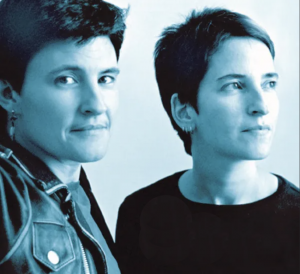 What emerged is the story of two women who have showed up to bear witness and, in their lyrics, to speak truth to power at hundreds of protests, demonstrations, and non-violent actions. Their repertoire recalls the flash points of national crises and injustices over two decades. They are spiritual first responders, often writing a song in the car just hours before they perform it at a rally.
What emerged is the story of two women who have showed up to bear witness and, in their lyrics, to speak truth to power at hundreds of protests, demonstrations, and non-violent actions. Their repertoire recalls the flash points of national crises and injustices over two decades. They are spiritual first responders, often writing a song in the car just hours before they perform it at a rally.
What I like about their songs is that they are not diatribes or rants, though God knows, there is much to rant about. Their music is righteous, but righteous in a way that invites people to come together rather than hole up in ideological bunkers.
They’ve sung One By One at a vigil at the gates of the School of The Americas, the infamous torture school at Fort Benning, Georgia. They’ve sung We Are One, a prayer for the reunification of a people, on the DMZ between North and South Korea. In Refugee they chronicle the plight of undocumented women and children. They wrote Silent Spring, an ode to the prophetic environmentalist Rachel Carson. After 9/11 they wrote and performed Peace, Salaam, Shalom, near ground zero, to stand against the war fever that led to the invasion of Iraq. It’s a very simple song that has been sung around the world.
With Where Are You Now, Sandy and Pat shined a light on the poorest, ignored victims of Hurricane Katrina. They wrote the CodePINK anthem in support of the women’s anti-war movement, as well as Code Pink’s hilarious Take Your Vagina to the RNC to protest the censure of Michigan State House Representative Lisa Brown for simply using the word “vagina” in opposition to anti-choice legislation.
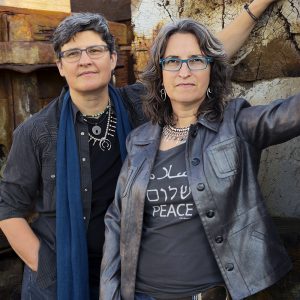
What’s most remarkable about Emma’s Revolution is that after twenty years they’re still going strong. Their relationship began when Pat invited Sandy to sing harmony on Bread and Roses, about a women textile workers’ strike that took place more than a century ago. They found that the harmony of their voices was compelling. They started doing gigs together, fell in love and got married. Thirteen years later they decided to uncouple, but kept writing and singing as a duo, maturing as veteran performers.
We are living in dark times. Often I’ve felt the darkness encroaching upon my soul, as I expect that many of you reading this also feel, but since I pledged two years of my life to make this film about “the Emmas” (as their friends often refer to the duo) I’ve been feeling a little bit lighter.
A friend told me the Emmas are just preaching to the choir. They’ve heard this before. In her song Choir, Pat writes…
Has anybody seen the choir?…
All I wanna do is get a glimpse of who they are…
Though we may never reach consensus
Hope is still within our reach
We can learn to live together
Put some motion in our speech
We are a mighty congregation
With strength beyond our means
We have the passion and the desire…
I am reminded of another turning point in my life when I went to live in Prague after the collapse of the Berlin Wall to make a film about life after communism. I was deeply inspired by the Czech dissident playwright, Vaclav Havel, who wrote about hope during his darkest time a prison where he was incarcerated for speaking out against a totalitarian regime.
[Hope is]… above all a state of mind, not a state of the world. Either we have hope within or we don’t; it’s a dimension of the soul ; it is not essentially dependent on some particular observation of the world or estimate of a situation. Hope is … an orientation of the spirit, an orientation of the heart; it transcends the world that is immediately experienced and is anchored somewhere beyond its horizons. Hope in this deep and powerful sense is not the same as joy that things are going well, or willingness to invest in enterprises that are obviously headed for early success, but rather our ability to work for something because it is good, not just because it stands a chance to succeed. – Vaclav Havel
To my short list of personal heroes that includes, Pete Seeger and Vaclav Havel, I now gratefully add the two heroines of Emma’s Revolution, Pat Humphries and Sandy O.
Liz Feldman
February 28, 2024 at 4:14 pmMy younger daughter first heard Emma’s Revolution at the School of the Americas protest during her college years. I had introduced her to Holly Near when she was a young child – what a delight to have her lead me to Emma’s Revolution! Our older daughter accompanied me to their concert in Harvard Square years later. After my mom died, we sat around the living room singing Swimming to the Other Side and Sing, People, Sing with my brother and his family. During the early days of Covid I joined their Facebook Livestream when they taught songs and kept our spirits up. We sing Bound for Freedom at our Passover Seder. Thank you for telling the story of these remarkable musicians and humans, who have accompanied me at so many meaningful moments in my life!
Christine Baxter
January 25, 2024 at 1:20 amThe first time I saw, heard, The Emma’s, was is an old Dutch Barn in Rotterdam NY. A project of the Schenectady Historical Society. I was a guest, and the driver for one of their members, a dear friend a mentor to me who was a wonderful storyteller from the United Kingdom. She is gone now and I think of that night and others at the Barn where I heard and sang along for the first time with Magpie and Charlie King and Joe Jenks and Reggie Harris. It is absolutely amazing to me that because of places like that and The 8th Step and Caffe Lena and Old Songs that this kid who’s Mom would play Helen Reddy one morning and Nancy Sinatra the next has met folx like Pat and Sandy and Holly. Thank you for the gift of this film and the stories it will tell.
Sheila Garrett
December 18, 2023 at 8:35 amHey Tom – This is Sheila Garrett again. I’m actively exploring a plan to get Pat and Sandy to the Monadnock region and hopefully, you too!
I’ve talked with folks at South of Monadnock community (formerly The Meeting School) and they’re up for it. Pat and Sandy could stay at the yurt, where I lived my last years there. It has been fixed up nicely and is available.
I would need to work on hospitality for you and Sharon, if she could come, but sure I could make that happen. Also wonder if you’ve had any contact with McDowell and thought at all about applying to come back there for a residency. Please let me know if we could work on this. Would love to help get you back.
Miranda
August 16, 2023 at 1:41 pmI am so thrilled that you have taken this heart project on — we have loved Pat and Sandy since first being introduced to them in 2016 by my daughter’s dance teacher. Every other year Laura Zweig and Emma’s Revolution collaborate on a dance performance/music show. It is soul-nourishing, heart-warming, poignant and beautiful. I cannot wait to see the documentary. Thank you Tom, and Pat and Sandy and all involved in this project. In love and gratitude, Miranda
Margit
May 6, 2023 at 9:43 amI have loved Emma’s Revolution since the first time I heard them sing with Holly Near in Berkeley, CA. I love the term “spiritual first responders” – and they also stick around to provide spiritual support to all of us working for peace and justice! I’m delighted to make a contribution towards production of the film; what a gift to document this fantastic duo.
Sheila Garrett
April 22, 2023 at 4:00 amHello Tom – What a joy to find you here and look back on those times when you stayed in my guest room at Thomas House while you filmed The Meeting School. I still watch it now and then when I can find a DVD player.
I talked with Pat and Sandy about getting you and them to come sometime to South of Monadnock community to do a fundraiser for your film on Emma’s Rev. I’m a total Emma’s Rev groupie and would love to see the three of you come to the former TMS campus. I’m working on it from this end but the folks living there are all extremely busy so it’s taking longer than I had hoped. I’m going to send them this link and hope it will help. Loved seeing you virtually at the concert to promote the film.
I’m living half the year in Jaffrey, NH and the warm months off-grid in a camper in Putney, VT. If you’re ever back in this neck of the woods, I can either offer you hospitality (Nov thru April) or find you a Quaker place in Putney or NH during warm months.
I’ll be thinking of you this month as I travel by train to Whidbey Island in Puget Sound. Won’t have time to visit the Bay Area as I want to get to Whidbey for the Penn Cove Festival. The Whidbey Quakes are doing some good work with local indigenous folks. You might be interested to check them out.
Blessings to you and thanks for all your great work, ? Sheila
Gwenyth Lewis
March 25, 2023 at 8:54 pmHow fabulous to learn about your film about “the Emmas,” who have uplifted me many times over the decades. And I’m delighted to learn that their name is derived from the life of Emma Goldman — I often cite her comment, “If I can’t dance, I don’t want to be part of your revolution!”
They are holding a concert in Albuquerque in April, and I can’t wait to get all my friends to hear them in person!
Thank you for making the film, Tom!
Jean Ellison
November 5, 2022 at 12:29 pmI have followed them for more than 10 years, probably a lot more! I’m 75, have been singing my whole life. Cut my teeth on the Weavers and Pete Seeger. Same Swimming to the Other Side in a Women’s chorus and love the Emmas’ music. They speak to my liberal hippie heart!
Diana Reynolds Roome
August 17, 2022 at 10:15 amAmazing! I realized I’d heard this duo during the darkest days of the pandemic, when they sang for a dance recital in Palo Alto in which my great niece performed. A film about the Emmas sounds like a marvelous and uplifting collaboration between all of you.
Jane Lucas
August 13, 2022 at 11:04 amThank you for writing and sharing this blog about two very remarkable women who are keeping hope alive. Evidence of the synchronicity of your meeting them keeps hope alive, too.
Catherine Lambie
July 16, 2022 at 1:49 pmDear Tom,
what a wonderful new journey you are on! Thank you for eloquently sharing about it…” The Emmas” sound extraordinary, I am going to check them out…Please keep us posted! And i love that you included the quote by Vaclav Havel, a favorite of mine…Thank you!
James Dean
July 15, 2022 at 8:25 pmTom,
Thank you for sharing this story of Pat and Sandy. It helps me to feel alive.
James